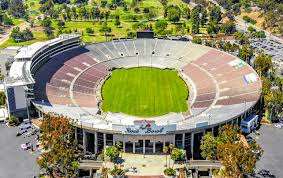Located in Pasadena, the Rose Bowl Stadium is famous all over the world. It has hosted five Super Bowls, two FIFA World Cup Finals, gold medal games for two Summer Olympics, annual Rose Bowl Game, and many superstar concerts. The Rose Bowl Stadium has also been regarded by Sports Illustrated as one of the Top 20 Venues of the 20th Century and the number one venue in college sports.
The History of Rose Bowl Stadium
Built in 1922, the Rose Bowl Stadium is recognized as a U.S. National Historic Landmark. It was designed by Myron Hunt, the architect who designed Henry Huntington’s house and the Ambassador Hotel.
Over the years, the Rose Bowl Stadium was expanded several times. Originally built as a horseshoe, it became a bowl in 1928 when the southern stands were completed. Having a modern capacity of 92,542 spectators, the stadium is the world’s 15th-largest stadium, the United States’ 11th-largest, and the NCAA’s 10th largest.

Rose Bowl Game
The Rose Bowl Game is the oldest of college football postseason bowl games in the US with the first played at Tournament Park on Jan. 1, 1902. The event has been hosted annually since 1916.
The Rose Bowl Game is widely known for many firsts: the first local radio broadcast of an East-West bowl game, the first transcontinental radio broadcast of a sporting event, the first national telecast of a college football game, and the first local telecast of a college football game.
It has traditionally hosted the champions of the Big Ten and Pac-12 conferences. Starting in 2015, the event became part of the College Football Playoff system and is paired with the Sugar Bowl in the semifinal rotation. It will also host one of its semifinal games every 3 years.
The Rose Bowl hosts its traditional Pac-12/Big Ten matchup during non-playoff years. The most recent College Football Playoff Semifinal took place at Rose Bowl Stadium on Jan. 1, 2018.